Whitman, 2005
ISBN-13: 9780807586570
 |
|||

|
Halloween Book List for Kids, 2011 |

|
|
The Monster Librarian Presents:
The Halloween Book List for Kids

Horatio's Halloween by Darlene Wanglund
School media specialist and children's librarian Kirsten Kowalewski provides a list of some favorite Halloween titles and reviews titles both new and old to consider for your Halloween collection/display.
You won’t find reviews here for most picture books on this list- there are just too many great Halloween books and spooky reads! Many of these are favorites of mine for reading aloud and sharing with kids. For additional titles, check out our Scary Stories for Kids
review section.***********
A Beasty Story by Bill Martin, Jr., illustrated by Steven Kellogg
Alpha-Oops: H is for Halloween by Alethea Kontis
Bone Soup by Cambria Evans
By the Light of the Halloween Moon by Caroline Stutson and Kevin Hawkes
Cinderella Skeleton by Robert D. San Souci, illustrated by David Catrow
Dorrie’s Magic and others by Patricia Coombs
Feliciana Meets d’Loup-Garou by Tynia Thomassie, illustrated by Cat Smith
Goodnight Goon by Michael Rex
H is for Haunted House by Tanya Lee Stone
In a Dark, Dark Room and Other Scary Stories (I Can Read) by Alvin Schwartz
In the Haunted House by Eve Bunting, illustrated by Susan Meddaugh
Little Goblins Ten by Pamela Jane, illustrated by Jane Manning
No More Monsters for Me! (I Can Read) by Peggy Parish, illustrated by Marc Simont
No Zombies Allowed by Matt Novak
Room on the Broom by Julia Donaldson, illustrated by Axel Schiffer
Scary, Scary Halloween by Eve Bunting, illustrated by Jan Brett
Tell Me a Scary Story… But Not Too Scary! by Carl Reiner, illustrated by James Bennett
The Ghost-Eye Tree by Bill Martin, Jr., illustrated by John Archambault
The Ghost of Sifty Sifty Sam by Angela Shelf Medearis, illustrated by Jacqueline Rogers
The Hallo-wiener by Dav Pilkey
The Little Old Lady Who Was Not Afraid of Anything by Linda D. Williams, illustrated by Megan Lloyd
The Runaway Mummy by Michael Rex
The Tailypo: A Ghost Story by Joanna C. Galdone, illustrated by Paul Galdone
This Book is Haunted(I Can Read) by Joanne Rocklin and Joann Adinolfi
A Vampire is Coming to Dinner! 10 Rules to Follow by Pamela Jane, ill. by Pedro Rodriguez*New Review
Price Stearn Sloan, 2010
ISBN-13: 978-0843199642
Available: New and Used
A Vampire is Coming to Dinner! is a cute picture book When a vampire is unexpectedly coming to visit a young boy for dinner, the book consists 10 rules that one must follow when a vampire invites himself to come for a visit. Each page gives one of the rules and the page then folds out to show a devious little boy in process of breaking the rules, to the dismay of the visiting vampire. All is well at the end as both child and vampire appear in a surprise popup, having a good old time! The art is clever and the mischievous little boy tormenting the vampire by breaking every rule is sure to get giggles out of children as they appreciate the sight gags.
Contains: Rampant rule breaking!
Ghost Dog
Secrets by Peg Kehret*New Review
Dutton Juvenile, 2010
ISBN-13: 978-0525421788
Available: New
Rusty can’t take his mind off of the German shepherd he saw chained to a tree in freezing cold weather. At the encouragement of a ghost dog, he starts to bring food and water to the German shepherd, and soon realizes that the dog is being abused. When the adults fail to resolve the situation, Rusty takes matters into his own hands, and has to make a decision: Would taking the dog be stealing, or rescuing?
Peg Kehret does a great job of capturing the emotions of a dog lover. The German shepherd, Ra, is loveable and sweet, every child’s ideal dog. However, I don’t see it as much of a horror novel. The ghost dog subplot was an afterthought at best. Kehret does a good job of navigating the moral gray area that is sometimes associated with rescuing neglected pets. The discussion of animal abuse and rescue was a little heavy-handed at times, but it does have a lot of good tips for animal lovers. I do recommend this book for children that love dogs, but not so much for children looking for something spooky. Note: Children who like this book may also enjoy The Ghost of Cutler Creek by Cynthia DeFelice.
Review by Cherylynne W. Bago
ISBN-13: 978-1582460789
Available: New and Used
Pumpkin Circle shows the life cycle of a pumpkin, from the time the seed is collected from a pumpkin in the fall, through its planting and growing, and finally to its harvesting, just in time to carve into Halloween jack-o-lanterns. Brief, simple text accompanies color photographs of children in the garden planting and taking care of the pumpkins as they grow. The candid photos will draw young readers into the story, and there are some good opportunities to talk about gardening, plants, and the life cycle- Pumpkin Circle is about much more than Halloween. Young readers may just love the pictures, though, especially in the last few pages, which show creatively carved jack-o-lanterns glowing in the darkness-a wonderful finish for the life of a pumpkin, as the cycle starts over again. This is a perfect preschool read aloud that can also be enjoyed independently by children in the early elementary grades. It’s not frightening, which makes it a good choice for children who are easily frightened at a time of year where scary stories rule. Note: Since it focuses on the life cycle of plants, it might be shelved in nonfiction, so librarians should take note to seek it out and promote it with the Halloween books Highly recommended for public library children’s collections and elementary school library media centers.
AlphaOops: H is for Halloween by Alethea Kontis and illustrated by Bob Kolar*New Review
Candlewick, 2010
ISBN-13: 978-0763639662
Available: New
In this Halloween themed AlphaOops story, the mixed up alphabet is getting ready to celebrate Halloween in traditional AlphaOops style. When the letter A isn't ready to start the Halloween alphabet, the letter H gets top billing. The other letters appear throughout the book representing different creatures and items of Halloween. Kontis includes some alphabet book in-jokes, as when the letter J apologizes to the jack-o-lantern for picking another word, saying "J can't always be for jack-o-lantern". Q, always a hard letter to get creative with, successfully breaks the mold, and S and X come up with an imaginative pairing. Unfortunately for the letter B, booted from his early place in the alphabet, other letters keep stealing his costume ideas. The letter P is a pirate, with the same costume as B's buccaneer; Y's yeti is identical to B's Bigfoot. Readers will cheer (and jump) when B finally gets the last word! The illustrations are fantastic and fun, and the kids will giggle at Bob Kolar’s art and Alethea Kontis’s story. AlphaOops goes a step beyond the typical letter representing a word in that the letters themselves have been given some personality. AlphaOops: H is for Halloween has catapulted itself up to a must have for any school library or public library’s children’s section and would make a great addition to any display. It is a wonderful read for kids who have become acquainted with the alphabet and is engaging enough that parents will enjoy sharing it with their kids. Once Halloween has passed, children and adults who love this book will want to check out the first book in the series, AlphaOops: The Day Z Went First
Ghoulish Goodies: Creature Feature
Cupcakes, Monster Eyeballs, Bat Wings, Funny Bones, Witches' Knuckles, and Much
More! (Frightful Cookbook) by Sharon Bowers*New Review
Storey Publishing, LLC; Original edition, 2009
ISBN-13: 978-1603421461
Available: New
My son REALLY loves cookbooks. A few months ago, he could only look at the pictures, but now he can read a lot of the words, and he will look at, talk about, and try to convince me to read the recipes and make them… right away! Right now he’s especially fond of Halloween cookbooks, so when I found Ghoulish Goodies among the new books at our local library, I snagged it for him right away. The introduction is dramatic and hooked him immediately, and the pictures are gorgeous. The author says it’s a “family-friendly” cookbook, so kids should be able to participate in making the recipes. She doesn’t say what ages she’s talking about, though, and while I learned some new and easy kitchen tricks, I can tell you that my kids (ages 3 and 5) don’t have the patience, and I don’t have the skill, to elaborately decorate cupcakes or shape jack-o-lantern shaped cookies by hand. Other recipes that sounded good, and looked like they would be reasonably simple, like "Orange Rice with Bacon", involved a lot more time than the recipe suggested and and didn’t really provide my kids with an opportunity to get involved- although the result was delicious. Other recipes that did allow the kids to participate a little more were still trickier that we thought they would be- when we tried making "Funny Bones" we discovered that it's a lot more difficult to dip pretzels with marshmallows in melted chocolate than it sounds. We had fun, but our final product looked nothing like the picture! Still, there are a lot of suggestions on how to create a creepy-but-not-too-creepy spread for a Halloween party, and the author's "mom-sense" attitude meant that I felt a lot more comfortable trying the recipes. Ghoulish Goodies contains creative and easy to read recipes, attractive pictures (although we would have liked to see more), and some simple ideas that could really impress guests at a Halloween party. It's a lot of fun to look at and to read. Unlike a lot of Halloween "idea" books, the recipes really are something you can see kids enjoying. But for the recipe-impaired, don't be deceived into thinking that the author's recipes are quite as "easy" as they look. If your kids like to cook, and like Halloween, they'll get very excited about Ghoulish Goodies. My son was thrilled to see us review it here. Just make sure to supervise closely, both for safety's sake and to intervene if the level of frustration gets too high. Recommended for families and for cookbook collections in either the children's department or general nonfiction collection in the public library. Librarians, make sure you seek it out for your Halloween displays.
Scary Stories
Treasury; Three Books to Chill Your Bones by Alvin Schwartz and
illustrated by Stephen Gammell *New Review
HarperCollins Publishers,1985
ISBN-13: 978-0060263416
Available: New and Used
The Scary Stories Treasury contains three popular volumes of “scary stories”, collected from folklore and urban legends by Alvin Schwartz: Scary Stories to Tell in the Dark, More Scary Stories to Tell in the Dark, and Scary Stories 3: More Tales to Chill Your Bones. Any librarian who isn’t familiar with the books collected in this volume really needs to check them out. Not only are these titles in high demand for older children and teens, but they are an incredible storytelling resource. In fact, in the introduction to Scary Stories to Tell in the Dark, Schwartz writes that scary stories are “meant to be told”.
Scary Stories to Tell in the Dark is the best known of the three books, and is the one I’ve used the most. It both starts and ends with “jump” stories, and these are fun to tell to a group. “The Viper” and “The Ghost with Bloody Fingers” are stories I’ve frequently told. Also included are the poem “A Man Who Lived in Leeds”, the song “Old Woman All Skin and Bone”, “The Hearse Song” and the Halloween game “The Dead Man’s Brains”. Other stories in the book include variants on familiar tales, such as “The Guests”, in which a young couple looking for a place to stay the night learn after the fact that their hosts were ghosts, and urban legends like “The Hook”, in which news that a murderer with a hook for a hand is on the loose spoils a date. Finally, there are some truly creepy and scary tales about ghosts, witches, shapeshifters, and the supernatural. While most of these come from folklore, and can’t be mistaken for anything happening today, they can still give readers, and listeners, the shivers.
More Scary Stories to Tell in the Dark has longer stories. Some are set in a specific historical period, such as “The Weird Blue Light”, which takes place during the Civil War. Many of them have sudden endings. In “Something Was Wrong”, we follow a bewildered and frightened John Sullivan around, learning only in the last few words that he is dead. Some folktales have clearly been adapted for a modern audience, such as “The Drum” an ominous contemporary variant of the folktale “The New Mother”. Schwartz doesn’t hold back or moralize when he retells a story. “Wonderful Sausage” is a clever and horrifying tale about a butcher who adds a special ingredient to his sausage. This volume also has a few more contemporary tales, ranging from frightening to tragic, and a description of the creepy sleepover game “A Ghost in the Mirror”. While the stories in this volume are more satisfying in many ways, I’d say these tales are aimed at a slightly older audience.
Scary Stories 3 continues with more detailed and sometimes complicated stories. In “Just Delicious”, a twist on the folktale “The Golden Arm”, a terrified wife feeds her husband a dead woman’s liver without his knowledge... and the woman wants it back. “Harold” is a chilling story of a vengeful doll. “The Wolf Girl”, set in a specific time and place, has its basis in the lives of real people, as does “The Trouble”, a story about poltergeist activity in the Lombardo household. “Maybe You Will Remember”, a baffling story about a girl whose sick mother disappears from her hotel, becomes truly horrifying when the reader turns to the notes at the back of the book to solve the puzzle. The volume wraps up with a couple of mildly funny stories. Of the three books, I’d say this is my least favorite, possibly because it is so grounded in detail, as details often distract listeners, making it harder to get them engaged in the story.
All three books have detailed notes and bibliographies provided by the author. While you don’t have to read the notes to enjoy the stories (with the exception of “Maybe You Will Remember”) they are easy to understand and interesting. All three books also have incredible illustrations by gifted children’s book illustrator Stephen Gammell, done in just black and white ink. It’s his illustrations that make the books so magnetic to kids... and so terrifying. The illustration for “Wonderful Sausage”, as an example, brings a whole new grotesque dimension to the story. With just a few strokes and some shading, Gammell ups the scare level considerably. Tormented, skeletal faces, ragged clothes, distorted and indistinct figures, glowing eyes and teeth, empty chairs, empty baskets, empty clothes... it’s enough to cause nightmares, and makes much more impact than if we had only Schwartz’s words. Many collections of scary stories from American folklore don’t include illustrations, or at least not effective ones, and that is probably one of the reasons why more of them aren’t well known. The Scary Stories books, however, are notorious, to the point that the series was seventh on the American Library Association’s list of the most frequently challenged books for 2000-2009, and the illustrations are surely a good part of the reason why these books in particular are noticed.
The main benefit of owning The Scary Stories Treasury is that you’ll have all three books in one volume. Each book appears to have been faithfully reproduced, with Gammell’s original illustrations. However, there’s no new or additional material here. Readers who don’t have the books and want them might want to consider this volume, but for those who already own them, there’s no reason to purchase it. I highly recommend that libraries of all kinds have at least one copy of each of the books included in The Scary Stories Treasury, and the Treasury itself might make a nice reference volume, and you’ll find that the Scary Stories books are rarely on the shelves. The Scary Stories Treasury is highly recommended to libraries and readers who do not already own copies of the Scary Stories books, and recommended as a reference volume for school and public libraries. Appropriate, based on maturity of the reader, for grades 4 and up.
Contains: Violence, gore, cannibalism, deception, the occult, witchcraft, murder.
Review by Kirsten Kowalewski
A
Tale Dark and Grimm by Adam Gidwitz*New Review
Dutton Juvenile, 2010
ISBN-13: 978-0525423348
Available: Pre-order
“Once upon a time, fairy tales were awesome”. That’s the hook the storyteller uses to pull you in to A Tale Dark and Grimm. In the first few pages he gleefully warns us that the tales of the Grimm Brothers are not as tame as the stories we are familiar with today- they’re violent and bloody.
Adam Gidwitz connects several of the stories from the Grimm Brothers and original content by following two children with very familiar names- Hansel and Gretel- on a winding, terrifying journey. There’s frequent commentary on the story, bolded to set it apart from the actual tale, and this does a neat job of translating the printed words into an almost conversational storytelling. It’s not hard to imagine these tales being told aloud, and I can imagine some interesting readers theater emerging from this!
While some of these stories will seem familiar, and there are predictable elements, there are still plenty of surprises along the way. Gidwitz doesn’t just retell the tales of the brothers Grimm, he makes additions and changes. Most of them are interesting and fun, and blend well into the original tale. Gidwitz doesn’t pull his punches, but since not all of his commentary is serious, some may not realize how gory it gets. It’s best to be prepared. Some of the tales he chose to incorporate into his story, notably “Brother and Sister” and “A Smile Red as Blood”, have the potential to be deeply disturbing. Parents may want to read ahead.
Beyond the overuse of “awesome”, I really enjoyed A Tale Dark and Grimm. Gidwitz shows obvious enthusiasm for these stories as both a reader and as a storyteller and teacher who has thought about and seen for himself the impact these stories have on children. This is not a book for the faint of heart, nor is it an easy read, but it’s a perfect antidote to the saccharine fairy tales most kids are familiar with, and, with its strong male and female protagonists, will appeal to both boys and girls looking for something with a darker tinge. Recommended. Grades 5-8
Contains: cannibalism, beheadings, dismemberment, soul stealing, torture, gambling, the Devil, mild language.Review by Kirsten Kowalewski
Sarah’s Little
Ghosts
by Thierry Robberecht, ill. By Phillipe Goosens*New Review
Clarion Books, 2007
ISBN: 978-0618892105
Available: New and Used
When Sarah breaks her mother’s necklace, her first instinct is to hide it and
pretend nothing is wrong. But as soon as the first lie passes her lips, a little
ghost pops out of her mouth and starts chanting the words she really ought to
say- “I broke your necklace”! Only Sarah can hear and see the ghost, but its
mere presence gets in the way of her relationship with her parents. With each
lie, another ghost pops out of her mouth, Soon she’s being chased by a horde of
chanting, singing ghosts.
The ghosts in Phillipe Goosens’ illustrations don’t look threatening at all.
They’re small, cute, and harmless-looking. Seeing them in a cloud around Sarah,
though, it hits home that even little lies add up to a lot of misery. While this
isn’t a particularly spooky story, the idea of lies literally catching up with
them will give the K-3 crowd the creeps, and the unscary representations of
ghosts are likely to cause a few giggles as well. Recommended.
Halloween
Day by Anne Rockwell, illustrated by Lizzy Rockwell*New Review
HarperCollins, 1997
ISBN: 9780064435895
Available: Used
Anne
Rockwell once again presents an accessible text aimed at preschoolers and
kindergarteners. The same class that appeared in Show and Tell
Day,
also a collaboration with her daughter Lizzy, is now preparing for the school
Halloween parade. An excited child narrates the story, describing her friends’
costumes and the party afterwards. The illustrations are colorful, with a gentle
humor, and complement the text well. This is a good book for first-time
trick-or-treaters who may be afraid of costumed characters, and a good
preparation for kids who have difficulty with transitions who haven’t
participated in a school Halloween parade in the past. I wish I’d had this book
at this time last year when my son participated in his first Halloween parade-
it would probably have been a lot more fun for everyone involved! While
Halloween Day isn’t particularly scary or a compelling page turner, it is a
worthwhile title for the children’s section of a public library or a school
library media center.
Halloween Night
by Marjorie Dennis Murray, illustrated by Brandon Dorman*New Review
Greenwillow Books, 2008
ISBN: 9780061351860
Available: New and Used
“Twas
Halloween night, and all through the house/Every creature was stirring,
including the mouse”.
So begins one of the stranger variations on “ Twas the Night Before Christmas”,
where instead of greeting Santa Claus, the residents of a haunted house prepare
for their visitors. The illustrations are a dead giveaway that readers should
expect a tickle to the funny bone. There’s a significant “gross-out” factor
that’s aided considerably by the illustrations- it’s one thing to read about
ogres setting up a buffet of live bugs, but the visual impact is another
experience entirely. There is a lot to see in the illustrations for those
readers who really want to take the time to look. Zombies march through a
graveyard that’s barely visible from the foreground of a basement scene; the
chairs are decorated with skulls, each with its own expression; a one-eyed
jack-o-lantern grins from the corner of a page. But the illustrations are just
part of what makes the story work. The truth is that kids rarely get to join in
with the monsters to scare the pants off other kids, and it’s just plain fun to
be part of the plan and part of the party. The art is digital, and the
characters populating the pages seemed to be drawn in a style similar to
Pixar’s. In fact, the illustrations scream out “Animate me”! The illustrations
aren’t enough on their own, though- the characters need the driving force of a
silly, gross, and maybe-a-little-bit-scary story. Halloween Night will
probably be most appreciated by kids in grades 2-5. Recommended for elementary
school library media centers and public library children’s departments.
Mouse’s
First Halloween by Lauren Thompson, ill by Buket Erdogan.
Simon & Schuster Children's
Publishing, 2000
ISBN-10: 0689831765
Available: New and Used
Mouse’s First Halloween won’t inspire fear, but when you read it aloud, it might make your toddler jump. Thompson offers a suspenseful setup, “Deep in the shadows/Mouse saw something flickering”, then breaks the tension with Mouse’s frightened squeak. Turn the page and the author reveals that the mystery is “not so scary after all”. It’s pretty clear from Mouse’s friendly appearance that this isn’t going to be a book to terrify, but Erdogan uses dark colors and outlines effectively to engage the reader’s imagination about what exactly could be rustling around in the night. Turn the page and even things that might be scary to kids (or mice) are portrayed at their most benign (and cutest). The book ends on a positive note, making it a good choice to share with first-time trick or treaters. Recommended.
Review by Kirsten Kowalewski
HarperFestival; Mti Rep edition, 2008
ISBN: 0061649694
Available:New
When I saw the advertisements for the movie Coraline,
I knew that with a 7 year old I would have to watch the film so I quickly
grabbed the book off the shelf to make sure I'd read it first.
How weird it all is... I read it in just about a half an hour or so... and
it was creepy.
Little Coraline is bored. Both of her parents work at home,
but they are always busy with work, and rarely have time to play with her.
She wanders about their house (a flat converted from a much larger house)
and visits with the neighbors. They don't seem to really notice her, though-
everyone talks at Coraline rather than to her. She enjoys exploring and
eventually comes across a door in her flat that opens to a brick wall. Her
mother explains that it used to be a door that went into the neighboring
flat, but now it's bricked up in case they rent it out.
Suddenly strange things crawl through the night, and the door that once led
to a wall of bricks, opens to a long dark hallway, and a world disturbingly
similar to the one she just left... only with frightening and sinister
undertones. Coraline uses her strength, intelligence, cunning and
determination to find her missing parents, and to get back home.
As an adult I thought to myself - this book will scare the crapola out of
little ones! In the back, though, Gaiman states that the book was
frightening to adults but an exciting adventure to children. Perplexed, I
handed it off to my 7 year old. With a little help, he made his way through
it. Not only did he manage to read it, but there were no nightmares. He was
thrilled with it and can't wait for the movie. I'm still perplexed as to how
this book brings out such completely different emotions in children and
adults. I don't know that the movie will be able to pull it off... I have a
hunch that the movie might encourage leaving the light in the hallway on at
night.
If you are an adult, don't let that stop you from reading this wonderful
book. Although a door opens into another world, I wouldn’t compare it to
Narnia. Think of it more like Alice in Wonderland(and not the Disney
version either), or The Wizard of Oz, focused on the scenes with the
flying monkeys and the witch.
Highly recommended, excellent novel. Read it to 7 and up, readable by 10 and
up.
Review by Kristen D P
 They’re Coming For You: Scary
Stories that Scream to be Read
by O. Penn-Coughin
They’re Coming For You: Scary
Stories that Scream to be Read
by O. Penn-Coughin
You Come Too Publishing. 2008
ISBN: 9780981683607
Available: New
O. Penn-Coughin shares a variety of stories intended to chill the bones of the audience for Alvin Schwartz’s Scary Stories books. However, while Schwartz collected his stories from folklore and legend, Penn-Coughin has written these himself. In his introduction, Penn-Coughin makes suggestions aimed specifically at young readers on how to tell the stories orally. However, the definitions the author provides in the book’s margins suggest that he expects the reader to refer to them in a silent reading. The inclusion of instructions to would-be oral storytellers throughout affects the structure, effectiveness, and flow of the stories for silent readers, however. Some stories have also been written in dialect, which is distracting and will be frustrating to struggling readers. According to the author, the stories in dialect were intended to be told orally, to make them more engaging for a live audience, but I found that they subtracted from the stories’ effectiveness.
The stories are of varying quality. Some are genuinely horrifying, like “Into the Woods” and “Checked Out”. A few, such as “Man in the Box” and “Real Bad Burrito” are witty. “Shot at the Gas Station” and a few others could be used to bolster interest in social studies in Oregon, the author’s home state. And some of them, like “The Delicious Death of Jay Whitebread” are just annoying. Penn-Coughin also illustrated the collection, and his illustrations are a real strength of the book. His bizarre, indistinct black and white images provide plenty of opportunity for the imagination to run wild and are a perfect complement to a collection of scary stories.
They’re Coming For You: Scary Stories that Scream to be Read won’t replace Alvin Schwartz’s collections, but it is a reasonable supplement. Though flawed, the collection will win over its intended audience, and if scary stories are in high demand in your library, it’s a worthwhile purchase.
Review by Kirsten Kowalewski
 Pumpkin
Day, Pumpkin Night by Anne
Rockwell, ill. by Megan Halsey
Pumpkin
Day, Pumpkin Night by Anne
Rockwell, ill. by Megan Halsey
Walker &
Company, 2001
ISBN: 9780802776143
Available: New
I admit there is nothing scary about Pumpkin Day, Pumpkin Night. Still, it’s a great book for the Halloween season. With simple words and spare text, and lots of repetition, Anne Rockwell describes the experience of a child exploring a pumpkin patch, choosing a pumpkin, scooping out the insides, and carving a jack-o-lantern with his mother. Older readers may smile, looking back on the days when they roasted and salted pumpkin seeds in the oven (mine were always a little burned). Halsey’s illustrations fit the text well- uncluttered paper sculptures give the pages a three dimensional appearance, so pumpkins really look like they’re piled up, and even cast shadows in places. Clean lines and bright colors make this a perfect choice for sharing this Halloween tradition with a preschooler before venturing out to the pumpkin patch together.
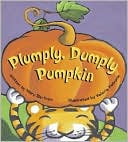 Plumply,
Dumply Pumpkin by Mary
Sarfozo, ill. by Valeria Petrone
Plumply,
Dumply Pumpkin by Mary
Sarfozo, ill. by Valeria Petrone
Simon &
Schuster Adult Publishing Group,
2004
ISBN-13: 9780689871351
Available: New
Lumpy, bumpy, showy, glowy, sunny, sumptuous… Mary Sarfozo obviously had fun playing with words when she wrote Plumply, Dumply Pumpkin. The story describes Peter, a joyful tiger, and his search for the perfect pumpkin to carve with his dad and enter into the jack-o-lantern contest. The rhyming is irregular, but instead of disrupting things, it simply keeps the story skipping along. Colorful, well-defined illustrations glow on the pages. You can’t read Plumply, Dumply Pumpkin without smiling, and preschoolers and early elementary students will love looking at the pictures and hearing this read out loud. Highly recommended.
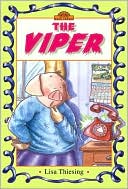 The
Viper by Lisa Thiesing
The
Viper by Lisa Thiesing
Penguin Young
Readers Group
ISBN-13: 9780525468929
Available: New
Lisa Thiesing presents early readers with a not-so-scary version of the campfire “jump” story called The Viper. With friendly cartoonish illustrations and foolish, likable Peggy the Pig as a main character, the story is more silly than suspenseful. Thiesing also uses the story to introduce concepts of time, including years, seasons, months, days of the week, minutes, and seconds, but her handling of this seems confusing and inconsistent. As the arrival of the Viper gets to its final countdown, the story picks up, with its funniest and most suspenseful moments right at the very end. The last moments of the story make this a great read-aloud. The “bong bong bong” of the clock just as the Viper raps on the door will make kids jump, and the punchline to the story, when read out loud, will make them giggle. Beginning readers who find the traditional easy readers bland will find a lot to appreciate in Thiesing’s work, and librarians will find this book a refreshing addition to their collection. Recommended.
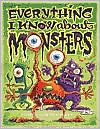 Everything
I Know about Monsters by Tom Lichtenheld
Everything
I Know about Monsters by Tom Lichtenheld
Simon & Schuster Books for Young Readers, 2002
ISBN: 068984381x
Available: New
On the first page of Everything I Know about Monsters, author Lichtenheld admits that there are no such things as monsters outside of the ones created by our imagination. He then proceeds to give us a tour of the various monsters from his imagination. Lichtenheld’s creatures are commonplace monsters- the monster under the bed, the monster in the closet, and the various monsters in the basement. Lichtenheld’s guide makes them relatively harmless and easy to get rid of. The illustrations are light, humorous, and complementary to the text. Everything I Know about Monsters will be a favorite of small children for its illustrations, and the humorous text (and gross-out factor) will also appeal to older elementary students, especially boys, looking a fun monster book.
Contains: n/a
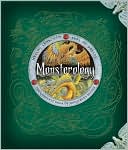 Monsterology: The Complete
Book of Monstrous Beasts ed. by Dugald A Steer
Monsterology: The Complete
Book of Monstrous Beasts ed. by Dugald A Steer
Candlewick Press, 2008
ISBN: 9780763639402
Available: New
Monsterology contains a guide to mythological monstrous beasts, written by the fictional Dr. Ernest Drake. The book is oversized, with an attractive cover, and the contents are presented in an almost “scrapbook” format. Drake divides his text into chapters, and in each chapter writes about his journeys to distant lands and the creatures he finds on his travels. There are a variety of photographs, illustrations, and maps, and each creature is pictured next to Drake’s description, which includes information about their geographic location, lair/nest, size, forms of attack, and food.
Monsterology is visually impressive and gorgeously illustrated. It begs to be touched, with foldouts and tactile sections where readers can touch a unicorn’s hair, a salamander’s skin, and the scales of a sea serpent. The visual nature of the book and its interactive features guarantee that monster-loving children at all reading levels will enjoy Monsterology, but younger children interested in the detailed text will need an adult’s help to read and understand it. While the interactivity of the book helps immerse the reader in Dr. Drake’s world, it will present a challenge for librarians as these types of items are easily torn or damaged from frequent use (or even use by a single overly rambunctious child). The book is designed for ages 6+ and as long as librarians and parents keep this in mind before giving it to a child, the book should survive the experience. Monsterology is a volume in the Ologies series and a companion book to Dragonology. It is an excellent addition to the growing field of monster guides and encyclopedias, and would fit nicely beside a Practical Guide to Monsters.
Contains: n/a
 Encycopedia
Horrifica by Joshua Gee
Encycopedia
Horrifica by Joshua Gee
Scholastic, 2007
ISBN:9780439922555
Available: New
Encyclopedia Horrifica is a collection of articles on all things paranormal, from aliens to vampires to psychic powers. The end result is an unusual reference book, complete with index and selected bibliography that kids will dig into and enjoy reading. Encyclopedia Horrifica also has some educational components. For instance, it compares vampires and werewolves in the movies to their closest real world counterparts. There is an interview with a psychic spy, an excerpt from the journal of paranormal investigators staying overnight in a haunted house, and a discussion of real life zombies. The book is also interactive, with a chatty narrator and several quizzes and activities. The book’s design and visual appeal create a nice fusion of text with photographs, drawings, and a variety of other images, that will engage the reader’s imagination, making this a great way to reach reluctant readers. Parents and librarians may want to keep in mind that a book like Encyclopedia Horrifica can be a “jumping off” point for interested and engaged readers, which could lead to further exploration of some surprising and possibly disturbing topics. Highly recommended for school media centers and public libraries.
 Favorite
Scary Stories of American Children by Richard and Judy Dockrey Young
Favorite
Scary Stories of American Children by Richard and Judy Dockrey Young
August House, 1999
ISBN: 0874835631
Availability: New and Used
Favorite Scary Stories of American Children is a collection of 23 short and scary stories told in the oral tradition ranging from the truly creepy and frightening to pun filled groaners. the authors, who are professional storytellers, chose the stories based on the enthusiastic demands of their young audiences. The age appropriateness of each story is indicated using a code of pictorial symbols (for ages 5-6, 7-8, and 9-10), with the key to the code on the page opposite the title page. All the stories are intended to be readable by nine and ten year olds, but the authors note that stories aimed at younger children may not hold the interest of independent readers. Because of its attempt to cover a wide range of ages, cultures, and interest levels, the book is a mixed bag, including versions of classic scary stories like "The Red Velvet Ribbon" and folktales like "The Bloodsucker", as well as some that feel like story flotsam, such as "Stop the Coffin." This book would be a great resource for storytimes or for teaching storytelling to children, and has a variety of possible interdisciplinary connections for elementary classrooms. An afterword for parents, librarians, and teachers addresses the value of scary stories for children as well as some of the concerns and issues that may come up in the telling and reading of scary stories. Origins of the stories and a pronunciation guide for regional terms are also included in the back of the book. Favorite Scary Stories of American Children will appeal to children who have worn out Alvin Schwartz's Scary Stories books, as well as to parents, teachers, and librarians looking for a way to give their kids the shivers. Recommended for elementary school libraries, public libraries, and families. Contains: violence
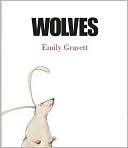 Wolves
by Emily Gravett
Wolves
by Emily Gravett
Simon &
Schuster Children's Publishing,
2006
ISBN-13: 9781416914914
Available: New and Used
Most people don’t think of the library as a dangerous place, but in Wolves, Emily Gravett shows that you can never tell what lurks within the pages of a book. Uncluttered pages illustrate an unwary rabbit who is so absorbed in his new library book, a nonfiction book about wolves, he absentmindedly walks into some real trouble. Those readers needing reassurance can take comfort in the author’s promise that “no rabbits were eaten in the making of this book”.
Wolves is really a “sophisticated” picture book. In spite of its appearance, it is not really aimed at the preschool crowd. Although the stated age range for the book is ages 4-8, the book really requires a good understanding of narrative(there are two endings) and the ability to “read between the lines” using clues from the pictures. Wolves also communicates a much different message than most children’s books, even disturbing and subversive titles. Subversive children’s books generally provide child readers with a sense of control and power in a world where their actions are determined by outside authorities. Sendak’s Where the Wild Things Are is an excellent example of this. Unlike Sendak’s book, though, Gravett’s work does not allow a child to take control. It actually creates a situation where the main character’s, and the child reader’s sense of security and power, is violated.
Wolves is more a work of ironic metafiction than a children’s book, and as such is more likely to be appreciated by older children and adults. And while children have their dark side, the grim humor doesn’t seem particularly age-appropriate for kids just getting the hang of “What’s green and sings”? Younger children may enjoy the illustrations (my son LOVED them) but most will miss out on the irony. However, older children, teens and adults who enjoyed the dark humor and postmodern illustrations in Gaiman and McKean’s Wolves in the Walls will probably get more out of Gravett’s contribution to the growing area of sophisticated picture books.
Front
Street, 2007
ISBN:
978-1932425581
Available: New and Used
A Child’s Guide to
Household Monsters is a
cumulative tale about a little
girl discovering that
traditional household monsters
she has been afraid of are not
as scary as they seem. The
monster under the bed, the
monster in the closet, the
monster in the attic, and the
monster in the basement, are
scared of one another, and she
ends up befriending them all.
Thach’s witty, rhyming couplets
give Udovic plenty of
opportunity to shape the tone of
the book, resulting in an
interesting juxtaposition. The
artist uses bright, almost neon
colors in places, that literally
glow in the shadowy darkness of
the pastel illustrations. The
goofy looking monsters are
endearing rather than
frightening, making this a good
book for children who appreciate
shivery fun paired with a little
gentle humor. Recommended. .
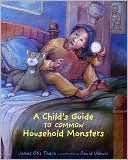 A
Child’s Guide to Household
Monsters by James Otis Thach,
ill. by David Udovic
A
Child’s Guide to Household
Monsters by James Otis Thach,
ill. by David Udovic 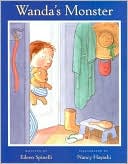 Wanda’s
Monster by Eileen Spinelli,
ill. by Nancy Hayashi
Wanda’s
Monster by Eileen Spinelli,
ill. by Nancy Hayashi
Whitman, 2005
ISBN-13: 9780807586570
Available: New and Used
Wanda is certain she has a monster in her closet. Her parents are certain she doesn’t. Granny, however, listens at the closet door and confirms it. Just as Wanda runs to hide, Granny points out that closet monsters have a bad reputation for a reason, “How would you like to live in a cold, dark closet?” What happens next is a surprise for both Wanda and her monster. Spinelli treats Granny, Wanda, and her monster with respect and humor, and Nancy Hayashi’s colorful, almost cartoony illustrations, will reassure children that they have nothing to fear, and quite a bit to enjoy, with Wanda ‘s Monster.
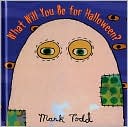 What
Will You Be For Halloween?
by Mark Todd
What
Will You Be For Halloween?
by Mark Todd
Houghton Mifflin Company,2001
ISBN-13: 9780618088034
Available: New and Used
What Will You Be For Halloween? uses short verses accompanied by illustrations to describe a number of traditional Halloween costumes. The book’s strength is the artwork. The bright colors and dark lines do a nice job of making the illustrations pop out from the page. The irregular outlines suggest children at work, carefully drawing their intended costumes. Luckily, the pictures do their work without needing explanation, since the rhythm is uneven and the lines do not fall in a predictable pattern. These flaws make it difficult to read the story aloud, although the illustrations scream out for exactly that. The lack of background information in a book clearly intended for young children is frustrating, as well. How many kindergarteners know what binary code is? Young children will like the illustrations, but the unpredictable text will throw new readers for a loop.
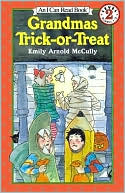 Grandmas
Trick-or-Treat(I Can Read Level
2) by Emily Arnold McCully
Grandmas
Trick-or-Treat(I Can Read Level
2) by Emily Arnold McCully
HarperCollins Publishers, 2002
ISBN-13: 9780064442770
Available: Used
Pip’s Grandma Nan takes manners seriously and refuses to dress up for Halloween. Her Grandma Sal thinks playing tricks and scaring people is the best part of the holiday. The problem is that while they argue, they are taking all the fun out of Halloween for Pip and her friends. The trick-or-treaters make a run for it, get lost, and are menaced by bullies dressed as pirates. Can Grandma Sal and Grandma Nan team up to save the day? Pip’s grandmas are unintentionally funny, and make a good “odd couple.” Kids will particularly enjoy the Halloween theme of this book, the second book Emily Arnold McCully has written about Pip and her grandmas. There are a limited number of easy readers when it comes to scary stories and Halloween, and this is a nice addition to that list.
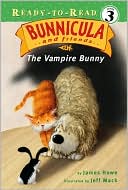 Bunnicula
and Friends: The Vampire Bunny
(Ready to Read Level 3) by
James Howe, ill. by Jeff Mack
Bunnicula
and Friends: The Vampire Bunny
(Ready to Read Level 3) by
James Howe, ill. by Jeff Mack
Simon &
Schuster Children's Publishing,
2004
ISBN-13: 9780689857249
Available: New and Used
Bunnicula and Friends: The Vampire Bunny is a nice transitional read for the child moving from easy readers to longer chapter books. The book is a shortened, simplified version of Howe’s popular chapter book Bunnicula. As with most easy readers, the focus is on the action, so readers won’t get the detail, background, and character development present in the original book, but Howe is a fine writer and does a good job of capturing the flavor of the story. The pacing is good, and the book will catch and keep the reader’s interest. Bunnicula and Friends: The Vampire Bunny would be a great choice for older reluctant readers as well. At 42 pages, with fairly advanced vocabulary and sentence structure for an easy reader, this book has the potential to attract the interest of struggling readers and build students’ comfort level with longer titles. Highly recommended.Q
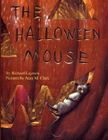 The
Halloween Mouse by Richard
Laymon and illustrated by Alan
M. Clark
The
Halloween Mouse by Richard
Laymon and illustrated by Alan
M. Clark
Cemetery Dance Publications,
October, 2001
ISBN: 158767047X
Available: New and Used
Ages: 6+
Timothy Maywood Usher Mouse
lives in the library, reading
about fantastic adventures. One
Halloween night, Timothy gathers
his courage to leave the library
to go on an adventure. After
escaping a run in with a snake
thanks to a piece of candy corn.
Timothy dreams of going trick or
treating but must first survive
an encounter with the
neighborhood cat involving a
jack-o-lantern. In the end, far
away from his cozy home in the
library, Timothy discovers that
having adventures is even better
than reading about them. Alan
Clark's illustrations are
detailed and colorful, and the
book is a visual treat. Richard
Laymon has created an engaging
(if lengthy)story. Although the
dialogue is awkward, Laymon's
inventive description and great
action sequences will grab the
reader. Laymon is writing as
much for adults as he is for
children: some vocabulary and
most literary references will go
right over children's heads, but
will add an extra dimension of
meaning for the adult reader. A
very cute Halloween picture
book. This book could be shared
with patient primary grade
readers as a read-aloud or with
intermediate readers either as a
read-aloud or as independent
reading.
Some more scary (and not so scary) stories for kids
For additional titles and reviews, visit our Scary Stories for Kids page!
Where the Wild Things Are by Maurice Sendak
The Boy With A Thousand Faces by Brian Selznick (reviewed here)
The House with a Clock in the Walls by John Bellairs
The Goosebumps books by R.L. Stine
Horror at the Haunted House by Peg Kehret (reviewed here)
The Halloween Mouse by Richard Laymon (reviewed here)
The Mysterious Matter of I. M. Fine by Diane Stanley
Dogzilla and Kat Kong by Dav Pilkey (reviewed here)
The Old Willis Place by Mary Downing Hahn
Deep and Dark and Dangerous by Mary Downing Hahn
All the Lovely Bad Ones by Mary Downing Hahn (reviewed here)
The Dollhouse Murders by Betty Ren Wright
Crandall’s Castle by Betty Ren Wright
A Beasty Story by Bill Martin and Steven Kellogg
The Lima Bean Monster by Dan Yaccarino (reviewed here)
Scary Stories to Tell in the Dark series by Alvin Schwartz
The Ghost Eye Tree by Bill Martin and John Archambault
Feliciana Meets d’Loup Garou by Tynia Thommasie and Cat Bowman Smith
The Ghost of Sifty Sifty Sam by Angela Medeairis and Jacqueline Rogers
The Dark Thirty by Patricia McKissack
The Dark Way by Virginia Hamilton
The Frightmares series by Peg Kehret
Bunnicula and sequels by James and Deborah Howe
Los Gatos Black on Halloween by Marisa Montes and Yuyi Morales (reviewed here)
Just a Minute by Yuyi Morales
I Spy Spooky Night by Walter Wick and Jean Marzollo
A Monster in the House by Elisa Kleven
The Hallo-wiener by Dav Pilkey
The Golem by David Wisniewski
The Viper by Lisa Thiesing (reviewed here)
Creepy Cuisine by Lucy Monroe
Fear This Book by Jeff Szpirglas
Fiona Loves the Night by Patricia MacLachlan, Emily MacLachlan Charest, and Amanda
Shepherd
The Aliens Are Coming! by Lisa Thiesing
The Best Halloween Ever by Barbara Robinson
Mouse’s First Halloween by Lauren Thompson and Buket Erdogan
It’s Halloween! by Jack Prelutsky and Marilyn Hafner
Dragon’s Halloween by Dav Pilkey
By the Light of the Halloween Moon by Carolyn Stutson and Kevin Hawkes
Who Stole Halloween? by Martha Freeman
Room on the Broom by Julia Donaldson
Halloween Skyride by Elizabeth Spurr
The Little Old Lady Who Was Not Afraid of Anything by Linda Williams
Darkness Slipped In by Ella Burfoot
Now that you have some books to read we encourage you to share a scare this Halloween!
We are encouraging readers this year to share a scare with friends and family.
This message is brought to you by the wonderful
folks at Spook House Dave!
 .and
MonsterLibrarian.com.
.and
MonsterLibrarian.com.
For those looking for ways to share a scare might we suggest:
Share a horror anthology with some friends, with each person reading a story and sharing it with the others. Stop by our Horror Anthologies page for some titles you might enjoy.
Read a scary story to a child, check our Halloween list for kids for some ideas
Tell some stories around the campfire or see if your local storytelling organization is holding an event.
Check out your local library to find a scary storyhour.
Listen to a podcast or CD with your family or students.
Try a book discussion. If you're feeling brave, try discussing it with your mom.
Go to a nursing home or assisted living facility and share a scary story with some of the residents- they may have a few tales to tell you, too!